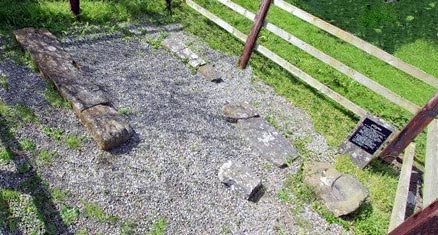
Grave of Gobán Saor, 16km (10Mls), from Thurles at Derrrynaflan, Ballinure, Co. Tipperary.
Little is truly known about ‘An Gobán Saor’, pronounced Gubawn Seer, (Gobban the Builder; free smith, free mason or free carpenter), whom legend states is buried 16km (10mls), from Thurles, at Derrrynaflan, Ballinure, Co. Tipperary.
Back in the days when our present ancient stone castles, monasteries, round towers and churches (now, alas, many, for the most part, in ruins), were originally being constructed, stone-masons /smiths /architects, just like ‘An Gobán Saor’ (also spelt Gubin Saor & Gobban Saer) and other possibly lesser skilled, associates, would have assembled at prearranged building sites, in the hope of obtaining gainful employment. Non-locals selling their skills would have travelled with their whole families, setting up camp close to the area where there was a promise of construction work.
According to legend, the father of the Gobán Saor was himself a famous mason and architect. Convention states that the Gobán Saor lived sometime around the seventh century. Folklore also indicates that he married a respectable and very beautiful Sligo woman. He possibly travelled extensively, often incognito, not just in Ireland, but also in England and even on the Continent, designing splendid sturdy edifices, while working as a common stone mason.
Folklore indicates that An Gobán Saor was highly intelligent, jovial and at all times generous with his knowledge. From the many tales told we learn that the traits he finds most difficult to understand are miserliness combined with greed.

Picture (A) Abbey Rd. area of Thurles and St. Brigid’s Graveyard (Shown circled in green), as it existed prior to 1846. Picture (B) The mason’s mark or symbol of ‘An Gobán Saor’, on a pillar beside St. Brigid’s Graveyard (Shown circled in red). The 2.4m pillar on this site was constructed in much more recent times possibly from stones relating to an older church building no longer evident on site.
To build these stone structures; these itinerant, skilled, stone masons would have remained camped in areas for many years, living, not in huts or houses, but in temporary tent-like dwellings, roofed over using bent, flexible, saplings covered in an oiled cloth to repel the weather. These nomadic skilled individuals were the past artists, designers, and architects, while also working as stone mason.

Stone carving of the cat with two tails, the mason’s mark or symbol of ‘An Gobán Saor’, in Thurles Co. Tipperary. This feline demonstrates a somewhat sad, frightened, stare at the visitor, while its set of whiskers points downwards.
Tales of An Gobán Saor‘s exploits verbally related down through the years’ state that he once applied seeking work to the master builder of a Cathedral. The master builder placed him in a work-shed by himself, and pointed to a block of stone inviting him to carve from it a cat with two tails. Next morning Gobán had disappeared, but when the master unfastened his shed and looked in, he found that the block of stone had been most beautifully carved into a cat with two tails. The Cathedral builder was heard to exclaim that this could only have been the work of An Gobán Saor himself, as no other human could have produced such superb work, and so fast.
So was born the mason’s mark or symbol, associated with An Gobán Saor; the cat with two tails, as shown above.
The story is also told that while building a monastery, the monks demanded that he lower his agreed price. To force this issue, they removed his climbing ladder from a castellated area he was building, preventing him from easy descent. Gobán began to slowly dismantle the stones structure, tossing the building materials to the ground, genially informing his employers below that this method of reaching the ground was as good as any. The monks are said to have quickly returned his ladder, and paid him his agreed price.
Because of the skilled ability of these itinerant builders, they were usually allowed, for the most part, to govern themselves. Sons inherited their skills and the trade secrets from their fathers, thus it was essential, that they would also develop their own private signs and a clandestine language, to ensure that these same trade secrets remained covert.
So also did the Tinkers; those specialising in skilled metal work, and some of this secret language, over the years, has made its way into the public domain; words like:- Kuenig (Eat), Án or Tes (Bread), Lokh or Lima (Milk), Chiman (Stick), Bós (Fist), Rístan (Prison), Krub (Foot), and a word used quite often today in conversation, which we relate to unemployment benefit; the word Dóle, which back then meant ‘Bread Trough’.
A Gobán Saor symbol can also be viewed by visitors attending at the Swiss Cottage, Cahir, Co. Tipperary, although same was possibly moved to this spot, in more recent times.

Leave a Reply